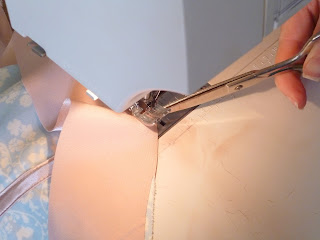 |
| The pattern we're using... |
Today for binding your edges, Sarah put together an excellent post for us. Her explanations are so nicely put together that there's not much for me to add! Her method is a really great way to control the quality of the binding that goes on. There are so many ways to bias bind an edge that we really don't want to overwhelm you with too much info here. I prefer to sew mine on completely by hand because crazy, unnecessary hand work soothes the neurotic person in me. You really don't have to do it that way.
~Sarah~
Before you get started, make sure you have inserted all of the bones you plan on using, and have tested the fit.
For your binding, you can use purchased bias trim or bias trim made of self or contrasting fabric. I'm using the same pink satin as I used to cover my bone casings. I am cutting bias strips 1 1/8" wide, and pressing my folds prior to stitching.
Baste your bias tape in place, leaving a little overhang on each end as pictured above.
With right sides of the bias tape facing and raw edges on the outside but folded up, stitch the bias tape together, as close to the back edge of your corset as possible. When we flip this right side out, we will have a nice, clean edge with a sharp corner. Below is what your stitched bias binding should look like.
Flip your bias binding around to how it will be stitched down, and you'll see how nice this finishes off the ends of your bias binding. Do this to both ends before stitching your bias tape down. You may need to "pull" your corner out with a pin (gently), to get a perfect 90 degree angle!
There are a few options for finishing the back of your binding. You can stitch by hand - I prefer the look of a slip stitch, but can use a cross stitch, straight stitch, or any stitch you like!
If you want to stitch my machine, like me, you can "stitch in the ditch." Stitching in the Ditch is when you top stitch over a seam. Can you see where my needle is going in the picture below? Right back into where I basted my bias trim on.
Stitching in the ditch makes for invisible stitching on the front, and a neat back. Do go slowly and stay within your original stitching line!
On the bottom edge of the corset there are lots of corners and points. When you come to a point, with your needle down, lift your presser foot and carefully "snip" into the bias binding, so it will easily curve around sharp corners.
There! all of your edges are finished, neat and tidy! Now we are ready for our garter clips and embellishments!
~Anna~
Didn't Sarah's corset turn out divine? Here's what mine looks like as well:
Here's a little additional tip for you. There are some corners and sharp points on the bottom of the corset, and these can be rounded out a bit by binding (which is how mine and Sarah's are) but some may prefer to bind so that it enhances the sharp point.
To get a sharp point on your center corset panel, see this post.












0 comments:
Post a Comment